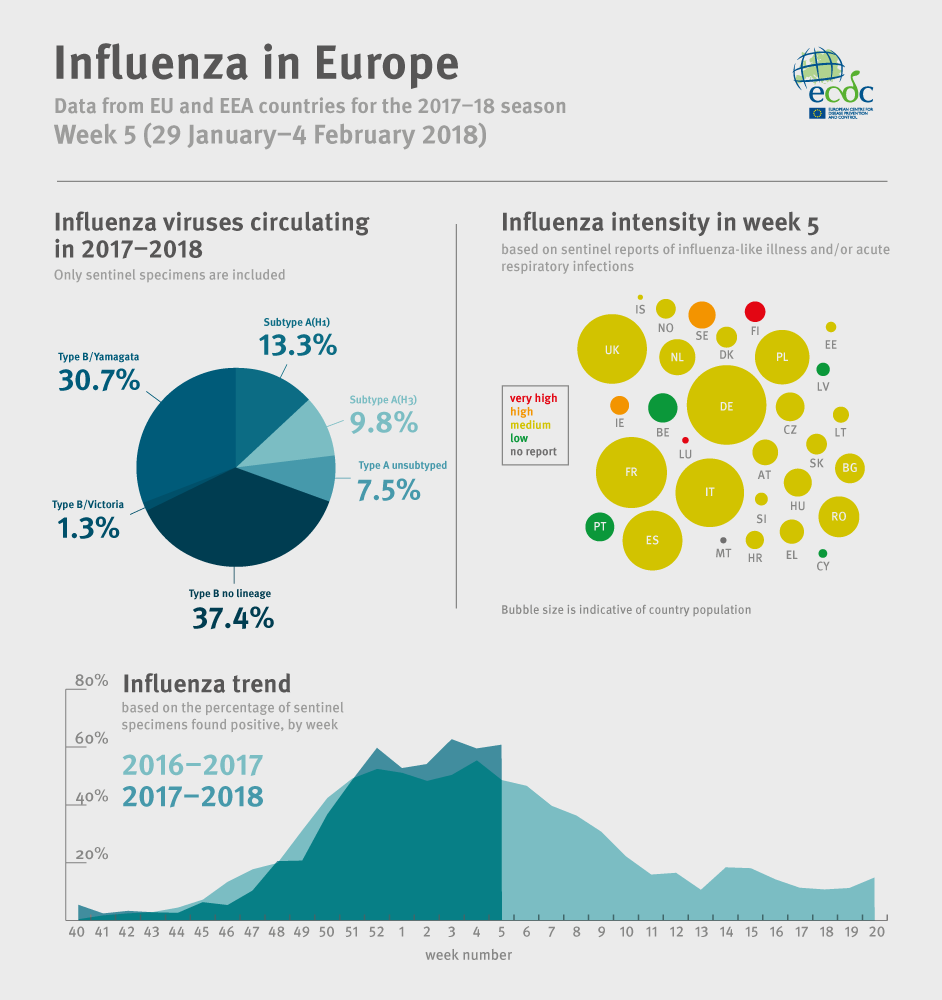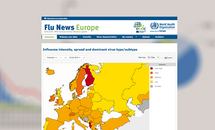Weekly influenza update, week 5, January 2018
Influenza activity was widespread in the majority of reporting countries. Both influenza virus types A and B were co-circulating with a higher proportion of type B viruses. Different proportions of circulating influenza virus types and A subtypes were observed between countries. Proportions of specimens positive for influenza viruses were increasing in the eastern part of Europe. Of the individuals sampled, on presenting with ILI or ARI to sentinel primary healthcare sites, 57% tested positive for influenza viruses, a slight increase compared to the previous week (54%).

Download

Summary
- Influenza activity was widespread in the majority of reporting countries.
- Both influenza virus types A and B were co-circulating with a higher proportion of type B viruses. Different proportions of circulating influenza virus types and A subtypes were observed between countries. Proportions of specimens positive for influenza viruses were increasing in the eastern part of Europe.
- Of the individuals sampled, on presenting with ILI or ARI to sentinel primary healthcare sites, 57% tested positive for influenza viruses, a slight increase compared to the previous week (54%).
2017/18 season overview
- For the Region overall, a higher proportion of type B compared to type A viruses has been detected in sentinel and non-sentinel sources. Of the type A detections from sentinel sources, A(H1N1)pdm09 viruses have outnumbered A(H3N2) viruses, while in non-sentinel sources more A(H3N2) viruses were reported than A(H1N1)pdm09 viruses.
- For type B viruses from both sentinel and non-sentinel sources, B/Yamagata lineage viruses have greatly outnumbered those of the B/Victoria lineage. The current trivalent seasonal influenza vaccine does not include a virus from the B/Yamagata lineage.
- Different patterns of dominant type and A subtype were observed across the countries in the Region, which may be due to the relative weights of information being derived from sentinel, non-sentinel and severe influenza case sources of information.
- The majority of severe cases are in adults infected by influenza A(H1N1)pdm09 or type B virus.
- While low in number, 58% of the genetically characterized A(H3N2) viruses belonged to clade 3C.2a, the clade of the vaccine virus described in the WHO recommendations for vaccine composition for the northern hemisphere 2017–18, and 38% to subclade 3C.2a1, with mammalian cell-cultured viruses in both clades being antigenically similar.
- A situation analysis that describes the early season evolving epidemiological pattern was published by WHO Regional Office for Europe in January. A high level of influenza B virus circulation is observed during the first half of the season, compared to previous seasons.
- An early risk assessment based on data from EU/EEA countries was published by ECDC on 20 December 2017.
- Interim or real-time vaccine effectiveness estimates from Canada, Stockholm County and Finland suggest overall vaccine effectiveness of 17-31%, depending on proportion of circulating (sub)types. Effectiveness against influenza B is in the range of 37-55%, despite the circulating lineage not being included in the more commonly used trivalent vaccine.
- European mortality among the elderly has significantly increased over the past weeks, except in central and eastern Europe.
- Additional information on global influenza activity is available from WHO’s biweekly global updates.







